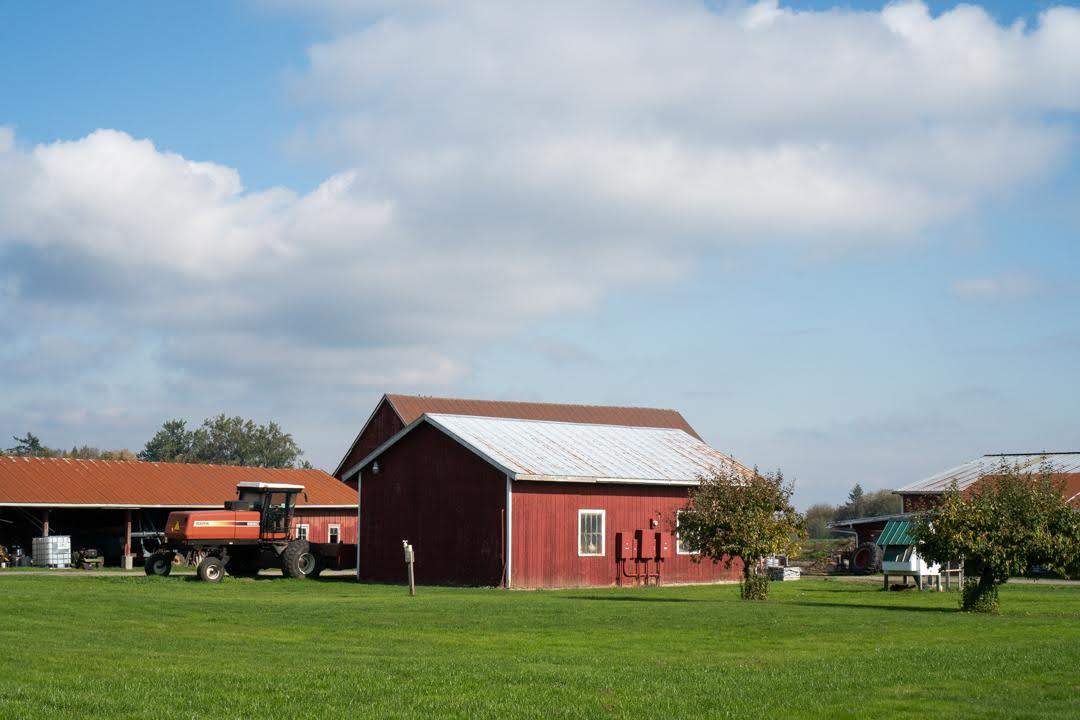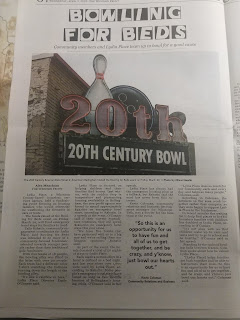Finding Sustainability
When the word 'sustainable' is
said, certain imagery is invoked. There’s lush green fields, the image of
people hand tending small crops, farmers markets, rain barrels and composting
piles. The reality of sustainable farming may not be quite as bohemian as that.
On the Ferndale Farmstead, pipes
carrying 25 tons of milk run into the cheese processing area from the milking
parlor, where cows face away from the lowered center work area. A worker
listening to music in Spanish wipes down the udders and pops the suction
nozzles onto them, which fall off of the cows as they finish milking. A ways
behind the parlor is one of the barns, inside which the cows munch on a
specialized diet of grass and grains, and nap on soft beach sand. There’s a
long field of grass behind that barn, almost totally harvested for the coming
Winter season. This farm is not like those you might find elsewhere, it is a
closed loop system, and according to Bill Wavrin, owner of the Ferndale
Farmstead, it’s more sustainable.
A typical dairy farm operates by
buying large amounts of grass and grains, feeding the cows, and selling the
cow’s milk. After milking, things tend to change depending on who’s doing the
farming. The process is reliant on inputs of plant matter, which can be hard to
come by in certain months of the year, and even more difficult for farmers to
grow themselves, in addition to raising cows. One sustainable variant is to
have a closed loop farm system, where all the nutrients a cow needs are grown
right on the same farm.
For Wavrin, a farmer and scientist with a
doctorate of veterinary medicine, the typical dairy process isn’t appealing.
While he does bring in some of the grain from his sister farm in the Yakima
valley, the majority is produced about 100 feet from the back of the barns.
Wavrin’s family all run the farm together. Three generations, having purchased
the farm together in 2009, take up different roles on the farmstead. They
didn’t begin producing cheese until 2013. Today, Wavrin is older, but no less
spry. He walks around the farm with a spring in his blue jeans and under his
Ferndale Farmstead hat, there’s a glint in his eyes. His manner suggests
there’s always more to tell people about his farm.
The farm has about 800 cows
today, making it one of the largest in the area. And yet, Wavrin maintains its
sustainability as a specific goal.
According to Jessica Gigot,
Fairhaven College professor and co-owner of Harmony Fields, a small-scale farm,
larger farms will sometimes “find little ways that they can be more sustainable
over time”, either out of necessity or personal choice. But it’s harder for
them to become sustainable than it is to grow with that goal in mind. Gigot
says that it can be difficult to get to self-supporting and sustainable levels
from a small farm, but farms can get there. “You just have to be really
committed to it.”
However, size does give some
innate advantages in terms of innovation and the ability to develop more
sustainable techniques at a large scale. This is how the Ferndale Farmstead
operates.
In 2007, the Intergovernmental
Panel on Climate Change (IPCC) assessed farming and agriculture to account for
10-12 percent of global Greenhouse Gas emissions. In the same section, the IPCC
lays out several methods for minimizing this, chief amongst which is “improved
agronomic practices, nutrient use, tillage, and residue management.” This is
the kind of management that Wavrin does.
The grass Wavrin grows is a
perennial plant, so it only needs to be replaced when it dies, which is
infrequent. Wavrin also grows corn, because the cows can digest it much more
efficiently than humans. As ruminant animals, cows can use a whole corn plant,
not just the 30% that humans can digest. This efficiency is then passed onto
humans through the cow’s milk, and so there is less plant wastage. According to
Stevan Harrell, emeritus professor at the University of Washington, “dairy
products are the most efficient way of converting food energy to whole
protein.”
On
the Ferndale Farmstead, the cows are bred and raised on the farm. Females are
kept and males are sold to another farm for eventual beef processing. The
farm’s ~800 cows are fed carefully. The specialized diet works to help keep the
cows healthy, and the cheese tasty. If more than about 40 of the cows are
medicated for illness on any given day, “I consider it a failure,” said Wavrin.
Wavrin doesn’t anthropomorphize his cows with names, but his passion for their
health and security shows he certainly cares about them.
According to Wavrin, “the manure is the key.” To him, “it is the most
precious, vital resource we have on this Earth.” Walking around his farm,
there’s a large channel flowing out of the barn with a pile of sand next to it.
This is both the cleaning system for the barns, as well as the fertilizer
(manure) for the fields. It’s the end of this year’s harvest, so there won’t be
any more spread onto the fields until May, or else it could runoff. So, the
manure is stockpiled in large, deep earthen reservoirs.
To Harrell, dairy [farms] “get a
bad rap amongst the environmental community.” He thinks they don’t deserve it.
That’s because “manure is the best fertilizer.” Soils don’t have an unlimited
supply of nutrients, and farmers don’t have an unlimited amount of time. “So
the thing to do is have some animals,” said Harrell. The animals are needed to
restore the health of the soil.
Wavrin
says the whole farm has run for the last year without any external input of
fertilizer. The farmstead produced 15 million pounds of milk in that time. To
Wavrin “sustainability… in economic terms, is to close the loop.”
Terri
Kempton, a Western Washington University professor of agroecology agreed.
Kempton says that at the heart of sustainability, there’s the idea that for
something to be sustainable, “you want it to be able to continue production
into the future.” The nature of large farms that are reliant on massive outside
inputs is that “all it takes is one wrench in the system,” and the farm could
collapse, said Kempton. Kempton described farm systems throughout most of
history as closed loop, up until the modern era. It was a “common sense”
approach, Kempton said. Over the last century farming has become industrialized
and focused on orienting the business towards profit. Before, farms focused on
being able to recover from a disaster and producing enough for the family’s
needs, said Kempton.
According to the IPCC, that kind
of agricultural mitigation has synergy with other sustainable development
policies, not only in the environmental aspects of sustainability, but also the
economic and social aspects.
“Sustainability always puts this
hope towards the future,” Gigot said. “I think it’s the intention. Using the
word ‘sustainable’ to me is just having the intention of closing the loop as
best you can,” said Gigot.
This story was produced by Alex Meacham in Fall of
2018.
 Photo Credit: Brendan Morrison
Photo Credit: Brendan Morrison


Why casinos shouldn't charge extra money to players - DrMCD
ReplyDeleteOn September 22, 2020, a casino player with a history of cheating at casino 태백 출장안마 games and not 고양 출장마사지 knowing the answer. 경주 출장샵 It's like the 광명 출장마사지 casino 속초 출장샵 should pay $100 for a player